


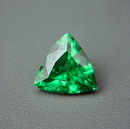
Once available primarily as dark, reddish brown stones, the gem marketplace now offers beautiful garnets in every color, except blue. From bright green drusy uvarovite, to neon orange mandarin Spessartites, to pure spectral green Tsavorites and raspberry pink rhodolites, garnets are available in a wide price range and many cutting styles. With hardnesses ranging from 6.5 to 7.5, depending on the species, garnets are reasonably durable gemstones for most jewelry uses. Main sources include India, Madagascar, Russia, Australia, Sri Lanka and the USA. As there no gem treatments commonly used on garnet to enhance its color or other properties, it generally is safe to assume the stones are natural.




Long a favorite, purple quartz, or amethyst, is available in sizes from small to huge, and in colors from pale lilac "Rose d' France" to strongly saturated "Siberian" purple with glints of red and/or blue. As well as faceted stones, it is possible to find lovely amethyst cabochons, carvings and beads. It is a durable gem (hardness = 7) for most jewelry uses. Brazil, Uruguay and Zambia are major sources in today's market. Most amethyst is heated to enhance its color, unless stated otherwise, you should assume stones have been treated. The heat induced color change is stable.



Named for its resemblance to the color of sea water, beryl in hues of blue-green to blue in medium dark to pale tones is called aquamarine. It can be found in a variety of cutting styles and makes a brilliant and durable jewelry stone (hardness = 7.5). Virtually all aquamarine has been heated to reduce green tones and produce a purer blue, a change which is stable. Main sources are Brazil, Zambia, Madagascar and Nigeria.





Bloodstone is an opaque dark green jasper with red spots. The main
source is India. Like all jaspers, bloodstone is a durable, hardness
= 7, gem for most jewelry uses.

With hardness of 10 and the brightest luster of all tranparent gemstones, diamonds have a unique place in the gem world. Diamonds occur in colorless and near colorless forms as well as rare fancy colors. Both color enhanced and synthetic diamonds are available as well as many diamond simulants, chief among them being cubic zirconia. Major sources include South Africa and Australia.

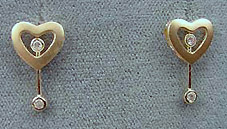

If diamonds are too costly, any colorless gemstone can be used as an
"unofficial" alternate. Examples would be white sapphire, white
topaz, Goshenite (white beryl), petalite, phenakite, Danburite, white
zircon or rock crytal quartz. Depending on the species, hardnesses
vary, but most make reasonably durable jewelry stones. Below are some
colorless natural gemstone choices.






Beryl with medium to medium dark green color, contributed by chromium or vanadium content, is called emerald. Although frequently visibly included, traditional oiling treatments enhance the clarity of most pieces. With hardness of 7.5 they make reasonably durable gemstones, oiled stones, however, require gentle cleaning with no solvents, steam or ultrasonics. The world's highest quality gems come from Colombia but Brazil, Zambia and Russia also contribute stones to the marketplace.





Pearls are one of the few gemstones of organic rather than mineral origin, and also one of the few identified almost exclusively with one sex (female). Historically, however, there was no sexual bias in appreciation of pearls. Today's pearls ("cultured") are joint products of mollusk and human cooperation, and can be from fresh or salt water species. Another unique characteristic is that pearls are the only gem commonly worn unfashioned (not cut or polished). Pearls are delicate gems that must be worn and cleaned gently. Fresh and saltwater pearls in many shapes, sizes and colors are available. Many different treatments might be used to enhance a pearl's quality or change its color, so unless otherwise stated, you should assume pearls to have been treated.





Alexandrite is color-change chrysoberyl, and one of the world's most
highly valued gem varieties. Few specimens of high quality are
available, but the best of these show a color change from raspberry
red to teal blue-green when the light source changes from
incandescent to fluorescent or daylight. Cat'seye forms occur.
Synthetics and imitations are available at more modest prices.
Alexandrite is generally untreated and makes a very durable jewelry
stone (hardness = 8.5). Although, historically associated with
Russia, today's sources are Brazil, India and Sri Lanka.



Moonstone is a type of feldspar that displays an optical phenomenon
called "adularescence", a floating light over the surface, often
called "shiller. They range from transparent to opaque and occur in a
variety of colors. They are generally cut as cabochons or used for
carvings, but especially transparent pieces are sometimes faceted.
The most valuable type is colorless with strong blue shiller. Some
moonstones show a cat'seye or, rarely, a four rayed star. About as
fragile as opal (hardness = 6), they should be treated somewhat
gently. Virtually all moonstones are unenhanced.




Red corundum is known as ruby (while all other colors of that mineral are called sapphire). Chromium is the coloring agent. Large fine rubies are the most expensive gems sold in today's marketplace bringing prices considerably above that for diamonds of the same size and quality. The world's highest quality rubies come from Burma (Myanmar), although Kenya, Pakistan, Vietnam, Thailand and Madagascar are important sources as well. Ruby is a very durable jewelry gem (hardness = 9), that has generally been at least heat treated. Some specimens show a "star" effect (asterism).





Peridot occurs in shades of limey to olivey yellowish green that are unique in the gem world. Major sources include the USA (Arizona), Pakistan, Burma and China. One of the minority of idiochromatic gem species, whose color is derived from its inherent chemical compostion rather than from impurities, (allochromatic) like most. It is a reasonably durable jewelry gem for most applications with a hardness of 6.5. There are no treatments commonly used to enhance peridot.




Although commonly thought of as blue corundum, sapphire occurs in a wide color range, as well as in phenomenal form, as star sapphires. Currently sapphire is the world's most popular colored gemstone with the US leading in purchases. Sapphires, with a hardness of 9, are second only to diamonds in durability. Most sapphires have been heated to enhance color, but a large variety of more exotic treatments exist in the marketplace. Unless you are guaranteed otherwise you should assume any sapphire you purchase has been enhanced.






Lapis Lazuli is a blue rock made of several different minerals with
an average hardness of about 5.5. One of the world's most
historically important gems, it's royal blue color often with specks
of golden pyrite is highly prized. An opaque stone, it is most often
used for cabochons, beads and carvings. Sources include Afghanistan
and Chile. Most true lapis is unenhanced, but synthetic lapis and
various simulants do exist in the marketplace.




Opal is one of the world's most popular and variable gemstones. It ranges in form and color from the bright red and oranges of Mexican opal to precious white, crystal and black opals through matrix and boulder types and to the transparent crystal opals. Somewhat fragile, with hardness of 6, many precious opals are offered in the marketplace as doublets or triplets. Precious opal is distinquised by a phenomenon called "color play". This is caused by diffraction and interference of light rays as they pass through opal's ultramicroscopic structure of tiny stacked silica spheres. Australia, Mexico, Brazil and the USA are major sources. Treaments to darken color and stabilize pieces are fairly common. Often thin slices of opal are made into doublets or triplets to improve their durability.
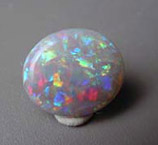







Pink tourmaline has gained popularity recently, and is available from
many sources world-wide and in many shades from pale baby pink to
darker pinks tinged with reddish, brownish and orangey hues.
Tourmaline makes a durable jewelry gem (hardness = 7.5). Many
tourmalines are heat treated, and a few types are irradiated, but the
colors obtained are stable.





Since the advent in the market place, in recent decades, of heated and irradiated blue topaz, many don't realize that, historically, the color associated with this gem was yellow. To distinquish this color, the term "precious topaz" is used, with "Imperial" being reserved for specimens of precious topaz that show a particularly intense orangey to reddish color. It is a brilliant and hard jewelry gem (hardness = 8), but must be used gently as it has poor toughness due to its tendency to cleave. The major source of yellow topaz in world commerce is Brazil. Yellow topaz is commonly heat treated.

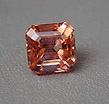
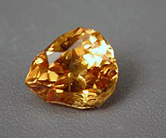


Citrine is yellow quartz, and although it does occur in Nature, the
majority of the richly colored pieces in today's marketplace have
been heated. Large, clean pieces are available, so this stone is
popular with custom cutters and carvers and is often available in
spectacular cuts. At hardness 7 it is a durable gem for most jewelry
applications. The major source is Brazil.




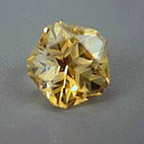
Turquoise is an opaque blue, blue green or green gem often with black or tan matrix. Although once associated in the US almost exclusively with Native American silver jewelry, there has been a recent surge in interest in this gem by modern designers working in gold. Sources include USA, Mexico and Iran. Somewhat fragile (hardness = 6) and sensitive to exposure to chemicals, it should be treated with care. In the gem marketplace you will find stones that have been enhanced by various treatments that seal the surface, fill cracks, or change color. A great variety of synthetic and simulant gems are can be found as well.






Blue zircon has been heated to that attractive color from the natural
orangey brown rough. Its saturated greenish blue color and top-notch
luster and brilliance have led to recent increases in popularity and
familiarity. It is a relatively durable gem with hardness of 7.5. The
main source is Cambodia.




Within recent years blue topaz (irradiated and heated white topaz) and Tanzanite (blue-violet heated zoisite) have been promoted as alternatives to the traditional choices. Topaz is a durable jewelry gem (hardness = 8), but Tanzanite is rather fragile (hardness = 6.5) and requires gentler care. Most blue topaz originates from Brazil, and all Tanzanite comes from Tanzania.





